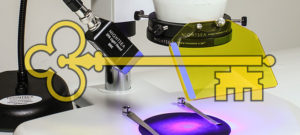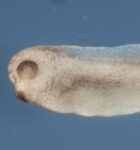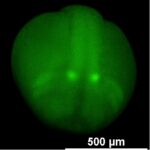KEY Award Recipient – 2020
Posted On: Tuesday, September 1, 2020

The recipient of the sixth annual (2020) NIGHTSEA/EMS KEY Award for New Faculty is Dr. Heather Ray, who is starting her new position as Assistant Professor in the Department of Biological Sciences at Idaho State University. The KEY Award was instituted in 2015 by NIGHTSEA founder Dr. Charles Mazel to acknowledge his own mentors and as a way of giving back to the scientific community. The annual award, sponsored jointly by NIGHTSEA and Electron Microscopy Sciences (EMS), includes a NIGHTSEA Model SFA Stereo Microscope Fluorescence Adapter system outfitted with two excitation/emission combinations plus $750 in supplies from the EMS catalog.
Dr. Ray received her PhD from The University of Colorado Anschutz Medical Campus, where she studied development of the neural tube in mouse embryogenesis. It was during this time that she fell in love with microscopy and specifically how transgenic animals and fluorescent reporter systems could be used to visualize developmental processes in vivo in real time. She started working with frog (Xenopus laevis) embryos during her postdoctoral fellowship at the University of Alabama, and came to appreciate their value as a model system to study how gene mutations lead to birth defects. Specifically, Dr. Ray focuses on craniofacial defects, which affect the skeletal structures of the face (including the jaws, palate and inner ear) and which comprise the largest class of birth defects worldwide. The craniofacial development of Xenopus is similar to humans at the genetic and cellular level, and the ability to easily genetically manipulate the embryos and visualize the structures in real time as they develop makes them a powerful model. She will use transgenic strains that express fluorescent proteins in neural crest cells, the ones that develop into the craniofacial structures. With the fluorescence as a reporter in combination with molecular, biochemical, and microscopy techniques, she can determine the consequences of genetic mutation specifically within these cells. The aim of this work is to increase our understanding of how genetic mutations affect cellular and tissue development, an understanding that will ultimately allow us to develop treatment interventions to prevent birth defects. Dr. Ray’s new NIGHTSEA system will provide her with the capacity to screen, dissect and image fluorescence-expressing embryos on a dissecting microscope in her own lab.
(Click image for larger view)
- Dr. Heather Ray
- Xenopus laevis, side view
- X. laevis expressing Sox10-GFP in developing neural crest cells
In addition to her research, Dr. Ray developed a passion for education and sharing with others the beauty that could be found in biological processes. She is excited to share her passion for Developmental Biology with students in her new position. She will utilize the many available transgenic and fluorescent tools in organisms such as hydra, zebrafish, Drosophila and Xenopus in combination with the NIGHTSEA system for students to see how cells segregate, proliferate and migrate and how disrupting these processes affects development. Additionally, Dr. Ray is developing a module for outreach in elementary science classes in local and rural communities and intends to use the NIGHTSEA system with transgenic tadpoles to show students tissues such as the heart, skeleton and muscle in living organisms and use this as a platform to increase student excitement for biology and talk about careers in research and human health.
The 2021 edition of the KEY Award will be announced in January.
Past recipients
- 2019 – Dr. Josh Currie (University of Toronto)
- 2018 – Dr. Pierre-Paul Bitton (Memorial University of Newfoundland)
- 2017 – Dr. Kristen Gorman (California State University Chico)
- 2016 – Dr. Sarah Petersen (Kenyon College)
- 2015 – Dr. Robert Mitchell (University of Wisconsin Oshkosh)



